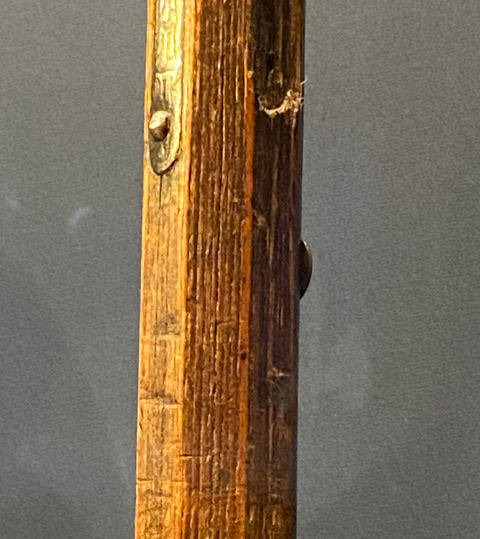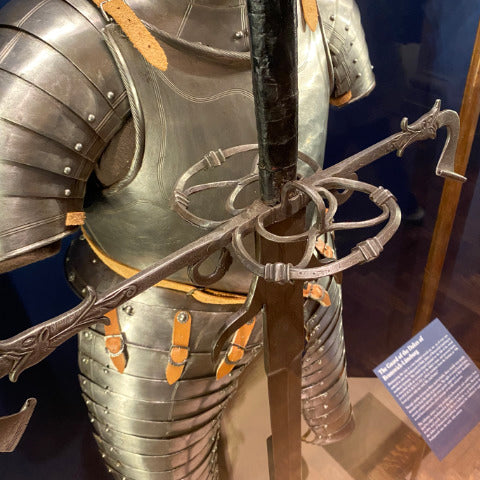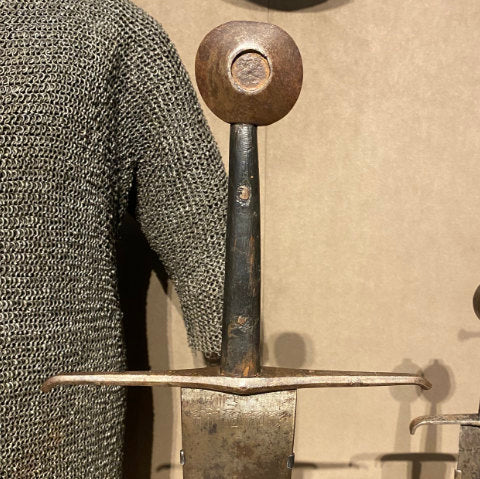Medieval Weapons, seeing the details
Carving of St Michael and the Devil, c. 1475-1500, Spanish.
This carving is a great example showing details of what they did in the past in multiple different ways. In this case they are different than many reproducers would choose to do today. But we can see a different solution on this very intricate statue.
The grieve on his lower leg has three buckled clasps holding it shut. Often one sees only one or two. The knee also seems to be a deviation from most that are seen. The knee cop does not come all the way to the edge of the two lames that is it attached to on the inside. In most examples we see it extend all the way to the edge of the lames. It also seems to have a single attachment point rather than two.
Falchion c. 1475-1500, Italian
When we look at some of the weapons in this exhibit, we see some great examples of different facets of the sword maker's craft. The falchion pictured above is a lovely example of his type of sword. The guard has an early finger ring and knuckle bow combination integral to the guard. While simple in shape its lines and form look appealing if not even sophisticated in how it was made and detailed.
When we are able to, we strive to get several different points of view of a piece. If we ever decide to replicate it this allows us to get the form and dimensions more accurately than just a profile view would allow. In the pic above we can see the pass through for the tang and a sense of the symmetry of the pommel.
Here we can see the way the guard was formed with the one side being split and then formed to create the fore ring and knuckle guard. The other is tapered and ends in a pyramidal bulge. The elegant tapering of the knuckle bow can be seen here as it thins then expands right near the end.
In this pic the pommel can be seen to be off set from the centerline of the tang. This is slight but may well have been intentional and if replicating such a piece it would not look quite right if done with everything lined up.
Next, we will turn to a large two-handed processional sword made for the guard of the Dukes of Brunswick-Lünenburg. This sword is massive and would have been very impressive with a large group of soldiers each carrying one proceeding the Duke. They had over 290 of them for the guard.
When we get closer we see the guard is quite complex and done with several components bound together or welded in place.
The detailing is quite fine and done with a very attentive hand. The animal head is nicely figured and set with hair and fine detail. The floral scrolling on the end of the arm is particularly nice and shows an intent to create an exceptional piece.
But as one sees on many medieval pieces the detail on the front sometimes does not go around the total piece. Here we see the thumb ring on this guard done quite rough from the hammer and welded to the guard with no attempt to finish the element off.
The famous group of swords sent as tribute to the
Sultan of the
Mamluk by the
King of Cyprus in 1419 is represented in the display by this beautiful sword. It is very similar to our
Leeds Castle Sword based on one in the same group. This sword is wide and long and has the distinct black wood grip riveted to the tang that was done when the piece were on display in the arsenal in Alexandria Egypt.
Medieval Sword before 1419, Italian.
The large wheel pommel with depressed center is impressive and like the falchion above we can see is slightly off the centerline. Most wheel pommels are not perfect circles, as we can see here, and it sometimes would have been difficult to align them even if they were striving to do so perfectly.
The inscription on the blade was done at the arsenal and has the name of the Sultan, year and identifies it as tribute. One can also just see the set of the blade in the guard and how the space around the blade is roughly shaped.
Below we can see the peen on the top of the pommel. This is the tang coming through the pommel and being set with a hammer to hold the sword together. We can see the depth of the inset in the pommel quite nicely as well.
Here is another example of a pommel peen on a fishtail shaped pommel. We often get asked how did they peen these but here you can see the rough peening of the tang in the space between the raised portions of the pommel. This is also a good view of the guard structure and pass through for the tang.
Finally let's check out this awesome glaive. It is one of the weapons made for the Guard of the
Electors of Saxony. The Electors would have matching weapons created for their guard over time and like the two hander we looked at earlier being used to demonstrate the power and wealth of the leader.
These high-status weapons are heavily decorated and show some interesting elements in polearm construction. In the picture below we see the detail on the
langets being similar to that on the socket but either by choice or inattention the pattern is reversed with the fork shapes going up on the socket and down on the langet. You can also see the langet on the side tucks under the socket as opposed to being welded to it.
In this pic we see one of the langets has been broken off. We do not know if it happened in its working life as a weapon or maybe when it had been retired some smith needed a bit of detailed strapping and removed it to be used somewhere else. This is not an unusual occurrence when looking at medieval weapons and armor. Were the strap is missing we can see the depth of the inlet in the wood to hold the langet and the holes were the nails have been pulled out.
The haft below the langets looks as if it has been in some rough use. Though when and where would be difficult to say. A guardsman's having to control a crowd or the pages messing about with old weapons in the armoury, who knows. The age and life story of such pieces is one of the most interesting aspects of studying arms and armor but also quite frustrating as we will never know the answers to some questions.

We hope you liked this jaunt around the museum with us and we hope your family has not given up and left you behind :-), it has happened.

Nathan Clough, Ph.D. is Vice President of Arms and Armor and a member of the governing board of The Oakeshott Institute. He is a historical martial artist and a former university professor of cultural geography. He has given presentations on historical arms at events including Longpoint and Combatcon, and presented scholarly papers at, among others, The International Congress on Medieval Studies.
Craig Johnson is the Production Manager of Arms and Armor and Secretary of The Oakeshott Institute. He has taught and published on the history of arms, armor and western martial arts for over 30 years. He has lectured at several schools and Universities, WMAW, HEMAC, 4W, and ICMS at Kalamazoo. His experiences include iron smelting, jousting, theatrical combat instruction and choreography, historical research, European martial arts and crafting weapons and armor since 1985




















